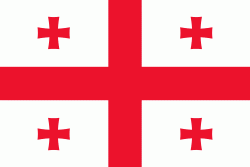Tbilisi (K'alak'i T'bilisi)
 |
 |
Because of its location on the crossroads between Europe and Asia, and its proximity to the lucrative Silk Road, throughout history, Tbilisi was a point of contention among various global powers. To this day the city’s location ensures its position as an important transit route for energy and trade projects. Tbilisi's history is reflected in its architecture, which is a mix of medieval, neoclassical, Beaux Arts, Art Nouveau, Stalinist, and Modern structures.
Historically, Tbilisi has been home to people of multiple cultural, ethnic, and religious backgrounds, though it is overwhelmingly Eastern Orthodox Christian. Its notable tourist destinations include cathedrals Sameba and Sioni, Freedom Square, Rustaveli Avenue and Agmashenebeli Avenue, medieval Narikala Fortress, the pseudo-Moorish Opera Theater, and the Georgian National Museum. The climate in Tbilisi mostly ranges from 20 to 32 °C in the summer and -1 to 7 °C in the winter.
The name "Tbilisi" derives from Old Georgian t′bilisi (Asomtavruli:, Mkhedruli: ), and further from tpili (Modern Georgian: , warm, itself from Old Georgian: ṭpili). The name T′bili or T′bilisi (warm location) was therefore given to the city because of the area's numerous sulfuric hot springs.
Until 1936, the name of the city in English and most other languages followed the Persian pronunciation Tiflis, while the Georgian name was ტფილისი (Tpilisi).
On 17 August 1936, by order of the Soviet leadership, the official Russian names of various cities were changed to more closely match the local language. In addition, the Georgian-language form T′pilisi was modernized on the basis of a proposal by Georgian linguists; the ancient Georgian component ტფილი (tpili, 'warm') was replaced by the newer თბილი (t′bili). This form was the basis for a new official Russian name (Тбилиси Tbilisi). Most other languages have subsequently adopted the new name form, but some languages such as Turkish, Persian, Greek, Spanish, and German have retained a variation of Tiflis.
On 20 September 2006, the Georgian parliament held a ceremony celebrating the 70th anniversary of the renaming.
Some of the traditional names of Tbilisi in other languages of the region have different roots. The Ossetian name Калак (Kalak) derives from the Georgian word ქალაქი (kalaki) meaning simply city. Chechen and Ingush names for the city use a form similar to or the same as their names for the country of Georgia (Гуьржех Gürƶex) as does the historical Kabardian name (Курджы Kwrdžə), while Abkhaz Қарҭ (Ķarţ) is from the Mingrelian ქართი (Karti).
Map - Tbilisi (K'alak'i T'bilisi)
Map
Country - Georgia_(country)
 |
 |
| Flag of Georgia (country) | |
During the classical era, several independent kingdoms became established in what is now Georgia, such as Colchis and Iberia. In the early 4th century, ethnic Georgians officially adopted Christianity, which contributed to the spiritual and political unification of the early Georgian states. In the Middle Ages, the unified Kingdom of Georgia emerged and reached its Golden Age during the reign of King David IV and Queen Tamar in the 12th and early 13th centuries. Thereafter, the kingdom declined and eventually disintegrated under the hegemony of various regional powers, including the Mongols, the Turks, and various dynasties of Persia. In 1783, one of the Georgian kingdoms entered into an alliance with the Russian Empire, which proceeded to annex the territory of modern Georgia in a piecemeal fashion throughout the 19th century.
Currency / Language
| ISO | Currency | Symbol | Significant figures |
|---|---|---|---|
| GEL | Georgian lari | ₾ | 2 |
| ISO | Language |
|---|---|
| HY | Armenian language |
| AZ | Azerbaijani language |
| KA | Georgian language |
| RU | Russian language |
















